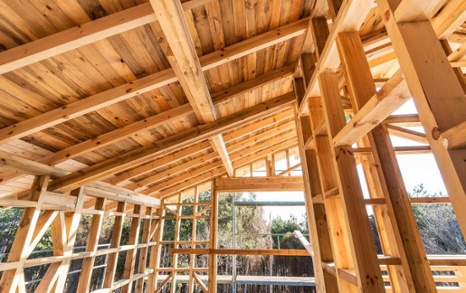
Zehnder: Is My Home Too Tight?
8/9/2017
The best way to ensure that a home is comfortable and healthy is to air-seal and insulate the home to a high standard and install a properly designed, continuous, high efficiency, whole-house ventilation system to help manage humidity, VOC and CO2 levels. A tight home and a whole-house ventilation system keeps your indoor environment healthy and saves energy. When you save energy, you save money.
Humans Breathe, Should Your House?
Ventilation standards like ASHRAE 62.2 are designed for the new construction of very tight, energy-efficient buildings. For healthy indoor air quality, the recommendation is for a natural air change rate of 0.35 ACH (air changes per hour), or just over 1/3 of the air in your home is replaced every hour. The average older home has a much higher rate of air-leakage than this, so it’s unlikely that you’ll have any concerns with a ‘too tight’ house until you undertake air sealing measures.
On the other hand, say you’re building or living in, a high-performance house with a well-sealed, well-insulated envelope. Sometime, somewhere, someone is going to ask the question, “Doesn’t a house need to breathe?”
They might point to houses that have been standing for 50, 70, 100 years and say they are in good shape because they ‘breathe’: air leaks let the structure dry out and that keeps the house healthy.
Well, no.
A ‘leaky’ house has a high rate of outside air being pulled in (infiltration) while inside air is being pulled out (exfiltration). Nature hates a vacuum but loves equilibrium; roughly the same amount of air is pulled out of the house as is pulled into the house, but you have no control over where air comes in or goes out in this air exchange cycle.
Air leakage causes drafts & contributes to uneven temperatures
The rate at which air leakage occurs is dependent on the air pressure around the house. For example, indoor air pollutants can sit stagnant in a “leaky” home for days if there’s no wind to drive the air exchange cycle. On the other hand, during a windy day in the winter, air leakage occurs at such a rate that a leaky home is basically on ‘re-heat’ every few hours. The problem is, even with your heating system working overtime, you’re likely still uncomfortable because of drafts and rooms that you can’t keep warm enough. A similar effect happens in the cooling season, where your A/C has to work hard but can’t quite keep you comfortable.
Heat loss is tied to the air exchange cycle in another way, the ‘stack effect’ when warm air rises. The stack effect causes heat loss most noticeably between the interior of the house and the exterior in the winter. As warm air rises and is pulled out of the house at an increasingly higher rate as the temperature difference grows. The taller the house, the stronger the stack effect.
A tight building envelope, with properly installed air and moisture barriers, stops the energy waste and improves your comfort level by minimizing the infiltration/exfiltration cycle, so the stack effect is controlled and your home is more comfortable.
Another problem with a leaky building envelope is water vapor (air laden with moisture) that can be pulled into wall and ceiling cavities, where it can condense and cause mold growth. Never a good thing.
In addition to energy loss and condensation in walls and attics, you have no control over the quality of the air that’s coming into a leaky house. ‘Fresh’ air pulled through a wall cavity or a basement header, may be laden with mold, pollen, dust, and other particulate matter. This isn’t going to provide a healthy living environment! Your indoor air quality is being compromised.
If you have carried out air sealing measures, and now find you’re having problems with indoor air quality, like condensation on your windows, musty smells, or visible mold growth in wet areas like bathrooms or laundry rooms, you need to bring fresh air back into the house. Doing so in a controlled manner, allows you to maintain comfort levels in all rooms, and provide filtered fresh air at the same time.
Build it tight and ventilate it right!
Whole-house ventilation is the best strategy to ventilate it right. You control the amount of air that comes in and out of the house; you control the quality of the fresh air that’s delivered. With a whole house, balanced ventilation system, you also get the bonus of recovering heat from the stale air that leaves the house during the winter. In summer, excess heat and humidity in the incoming air are transferred to the exhaust air.
Heat recovery ventilators (HRVs) and energy recovery ventilators (ERVs) are designed to keep your whole house evenly ventilated. Whole house systems work continuously to extract moist, stale air from wet rooms (kitchens, bathrooms and utility rooms) and supply fresh, filtered air to habitable rooms (bedrooms, living rooms, and dining rooms) year-round. Zehnder systems can be customized to suit your situation with new homes able to benefit from the whole suite of Zehnder HRVs and ERVs.
Retrofitting is a feasible option!
Existing homes can be more of a challenge, but more and more contractors are finding success using one of Zehnder’s ComfoAir units as a retrofit solution, even in their own homes. The ComfoAir line was designed to boost indoor air quality and increase energy efficiency. They use counter-flow air-to-air heat exchangers, while most HRVs in North America rely on parallel-flow heat exchangers. With counter-flow, the ComfoAir can achieve heat-recovery efficiency of over 90%.
Whole house ventilation gives high-performance homeowners peace of mind:
- Ensures a healthy indoor environment
- Eliminates condensation and high humidity levels
- Saves energy and improves comfort
Do you want to promote healthy indoor air for your new or existing home? Contact Zehnder America to learn more about our ventilation solutions or call 888.778.6701
